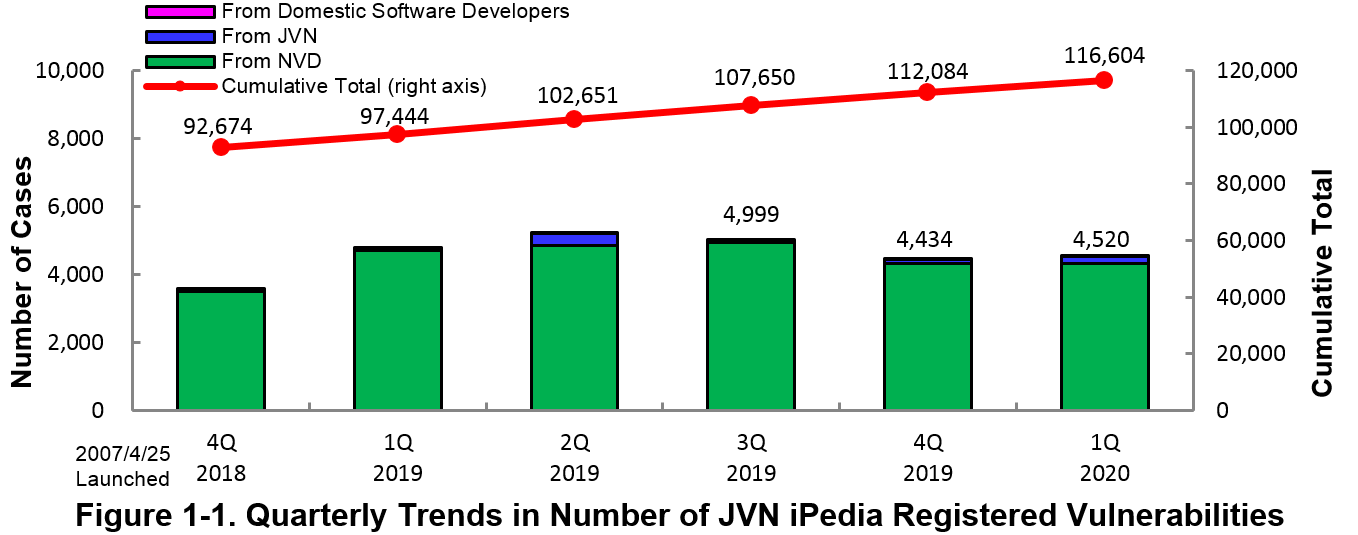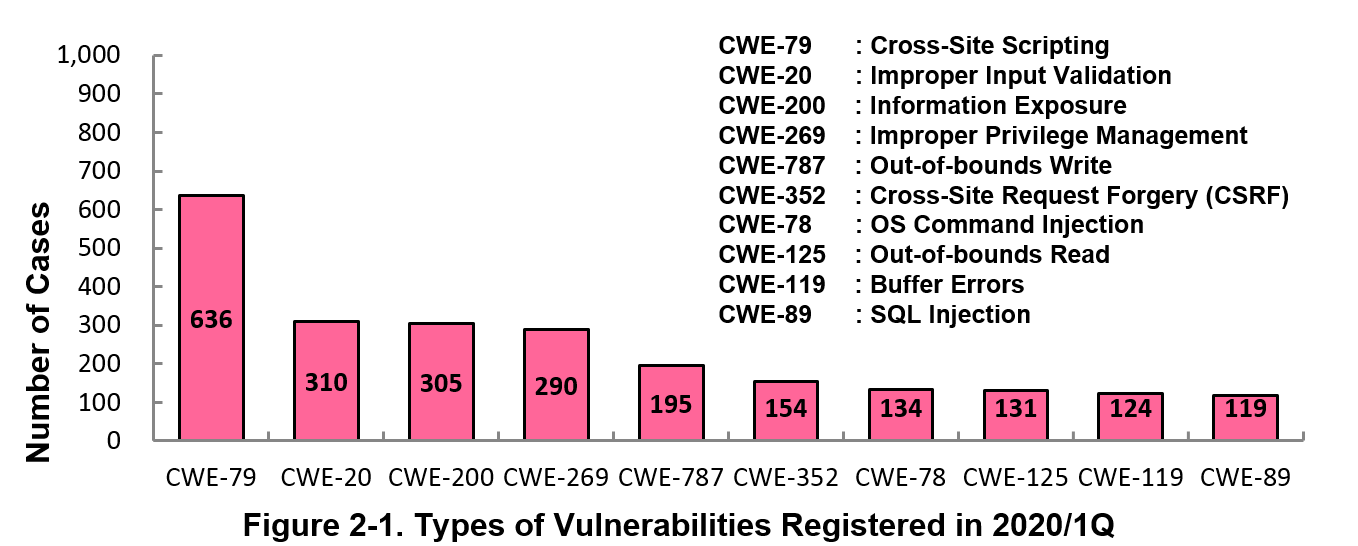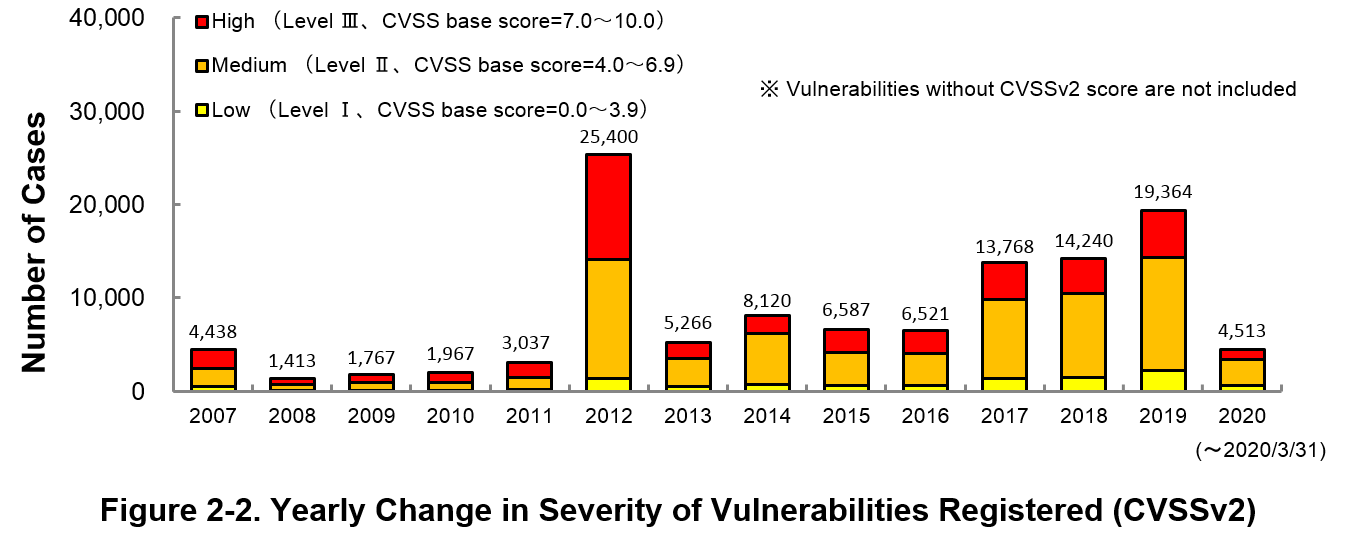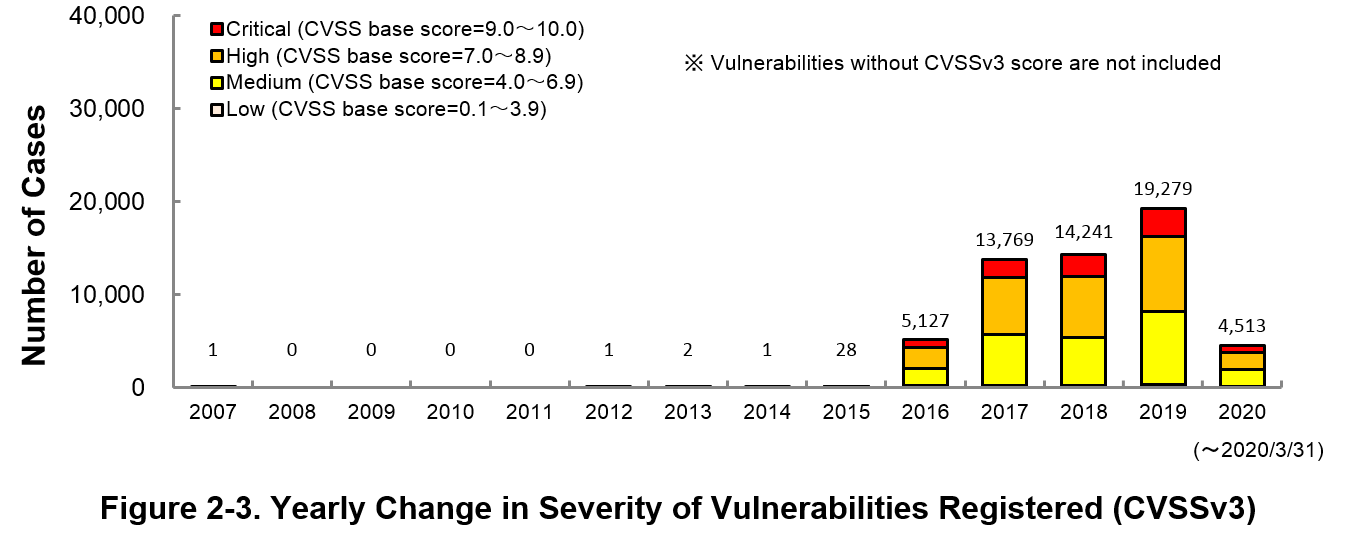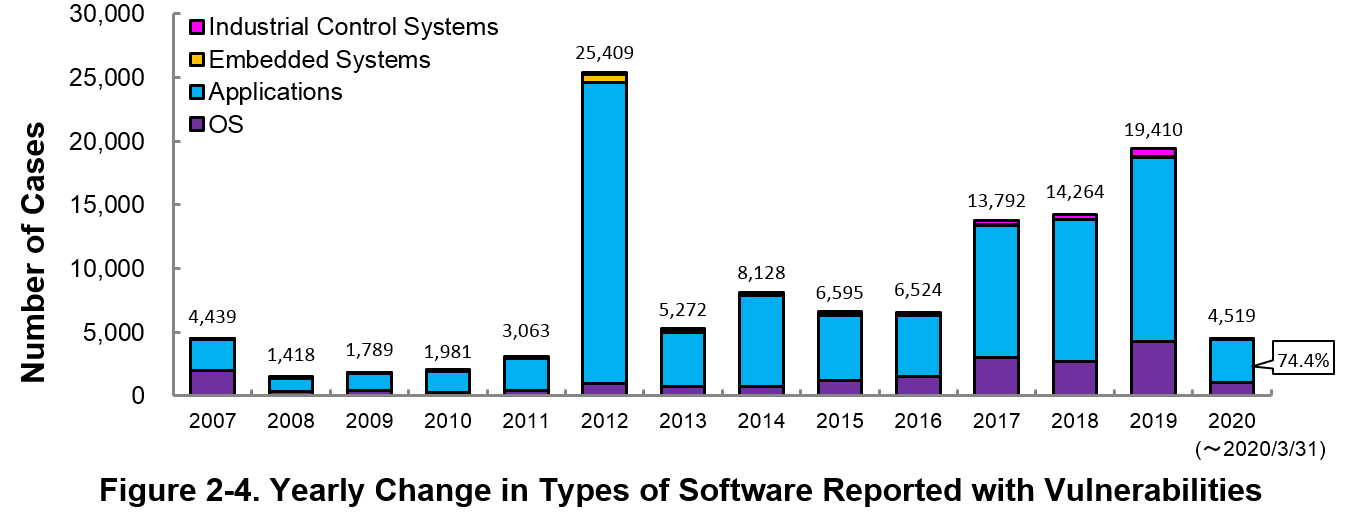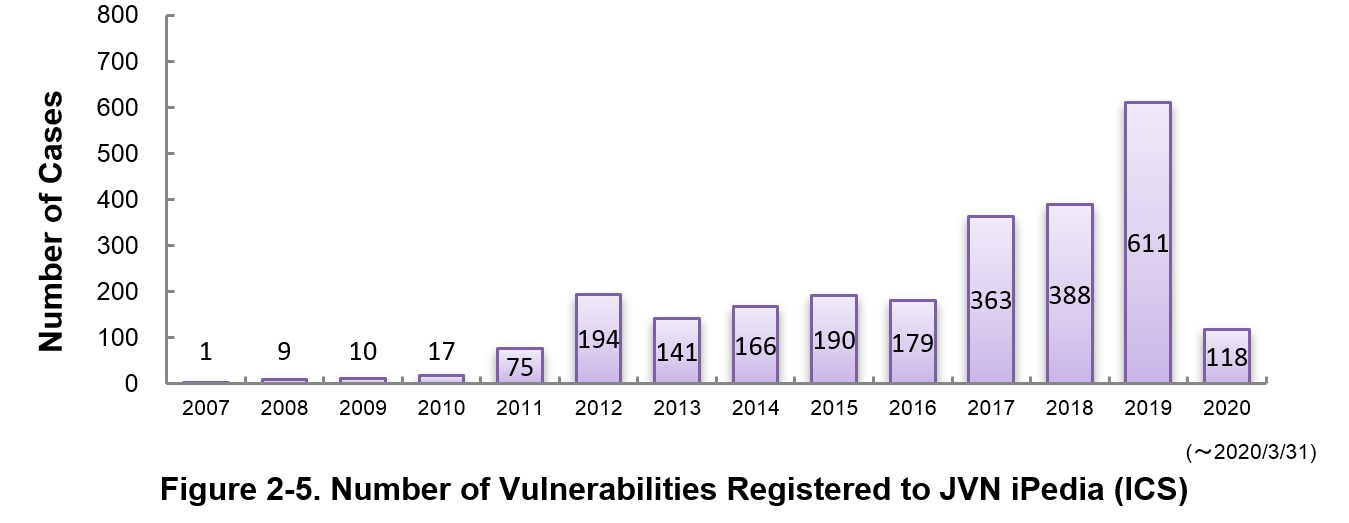Enhancing information security

Vulnerability Countermeasure Information Database JVN iPedia Registration Status [2020 1st Quarter (Jan. - Mar.)]
Release Date:Jun 17, 2020
IT Security Center
1. 2020 1st Quarter: Vulnerability Countermeasure Information Database JVN iPedia Registration Status
The vulnerability countermeasure information database JVN iPedia (https://jvndb.jvn.jp/en/) is endeavoring to become a comprehensive vulnerability database where vulnerability information is aggregated for easy access for IT users. JVN iPedia collects and/or translates the vulnerability information published by 1) domestic software developers, 2) JVN (*1), a vulnerability information portal run by JPCERT/CC and IPA, and 3) NVD (*2), a vulnerability database run by NIST (*3). JVN iPedia has been making vulnerability information available to the public since April 25, 2007.
1-1. Vulnerabilities Registered in 2020/1Q
~ JVN iPedia now stores 116,604 vulnerabilities ~
The summary of the vulnerability information registered to the Japanese version of JVN iPedia during the 1st quarter of 2020 (January 1 to March 31, 2020) is shown in the table below. As of the end of March 2020, the total number of vulnerabilities stored in JVN iPedia is 116,604 (Table 1-1, Figure 1-1).
As for the JVN iPedia English version, the total number of vulnerabilities stored is 2,132 as shown in the lower half of the Table 1-1.
Table 1-1. Vulnerabilities Registered to JVN iPedia during 1st Quarter of 2020
|
|
Information Source
|
Registered Cases
|
Cumulative Cases
|
|---|---|---|---|
|
Japanese Version
|
Domestic Software Developers
|
5 cases
|
232 cases
|
|
JVN
|
184 cases
|
9,061 cases
|
|
|
NVD
|
4,331 cases
|
107,311 cases
|
|
|
Total
|
4,520 cases
|
116,604 cases
|
|
|
English Version
|
Domestic Software Developers
|
4 cases
|
230 cases
|
|
JVN
|
35 cases
|
1,902 cases
|
|
|
Total
|
39 cases
|
2,132 cases
|
2. Details on JVN iPedia Registered Data
2-1. Types of Vulnerabilities Reported
Figure 2-1 shows the number of vulnerabilities newly added to JVN iPedia during the 1st quarter of 2020, sorted by the CWE vulnerability types.
The type of the vulnerabilities reported most in the 1st quarter is CWE-79 (Cross-Site Scripting) with 636 cases, followed by CWE-20 (Improper Input Validation) with 310, CWE-200 (Information Exposure) with 305, CWE-269 (Improper Privilege Management) with 290, CWE-787 (Out-of-bounds Write) with 195.
CWE-79 (Cross-Site Scripting), the most reported vulnerability type in this quarter, could allow attackers to display false webpages and/or steal information.
Software developers need to make sure to mitigate vulnerability from the planning and design phase of software development. IPA provides tools and guidelines, such as "How to Secure Your Website" (*4), "Secure Programing Guide" (*5) and "AppGoat" (*6), a hands-on venerability learning tool, for website developers and operators to build secure websites.
2-2. Severity of Vulnerabilities Reported
Figure 2-2 shows the yearly change in the CVSSv2 rating scale based severity of vulnerabilities registered to JVN iPedia.
As for the vulnerabilities added to JVN iPedia in 2020, 25.2 percent are “Level III” (7.0 - 10.0), 61.0 percent are “Level ll” (4.0 – 6.9) and 13.8 percent are “Level I” (0.0 – 3.9). This means 86.2 percent of all vulnerabilities registered are Level II or higher, which are potentially critical enough to cause damage like information exposure or data falsification.
Figure 2-3 shows the yearly change in the CVSSv3 rating scale based severity of vulnerabilities registered to JVN iPedia.
As for the vulnerabilities added to JVN iPedia in 2020, 16.2 percent are “Critical” (9.0 – 10.0), 40.5 percent are “High” (7.0 – 8.9), 41.8 percent are “Medium” (4.0 – 6.9) and 1.5 percent are “Low” (0.1 – 3.9).
To avoid threats posed by the known vulnerabilities, both product developers and IT users should pay close attention to vulnerability disclosure and update software they use to a fixed version or apply a security patch as soon as possible when they become available. IT users can check vulnerabilities newly published on JVN iPedia in RSS and XML format (*7) as well.
2-3. Types of Software Reported with Vulnerability
Figure 2-4 shows the yearly change in the type of software reported with vulnerability. Application vulnerabilities have been published most, accounting for 74.4 percent (3,362 out of 4,519) of the 2020 total.
Figure 2-5 shows the yearly change in the number of JVN iPedia-stored vulnerabilities in industrial control systems (ICS) used in critical infrastructure sectors. As of March 2020, the total of 2,462 ICS vulnerabilities have been registered.
2-4. Products Reported with Vulnerability
Table 2-1 lists the top 20 software whose vulnerabilities were most registered to JVN iPedia during the 1st quarter (January to March) of 2020.
In this quarter, Microsoft Windows 10 is the 1st rank. From 2nd to 20th, other Windows OS products are also ranked. In addition, many other vulnerability information for OS products are ranked, such as Apple Mac OS X etc.
Besides those in the top 20 list, JVN iPedia stores and offers vulnerability information about a variety of software. IPA hopes software developers and users will make good use of JVN iPedia to efficiently check vulnerability information and take necessary action in a timely manner (*8).
Table 2-1. Top 20 Software Products Vulnerabilities Were Most Registered [Jan. – Mar. 2020]
|
Rank
|
Category
|
Product Name (Vendor)
|
Number of
Vulnerabilities Registered |
|---|---|---|---|
|
1
|
OS
|
Microsoft Windows 10 (Microsoft)
|
188
|
|
2
|
OS
|
Microsoft Windows Server (Microsoft)
|
182
|
|
3
|
OS
|
Microsoft Windows Server 2019 (Microsoft)
|
174
|
|
4
|
OS
|
Microsoft Windows Server 2016 (Microsoft)
|
165
|
|
5
|
OS
|
Microsoft Windows Server 2012 (Microsoft)
|
131
|
|
6
|
OS
|
Microsoft Windows 8.1 (Microsoft)
|
127
|
|
7
|
OS
|
Microsoft Windows RT 8.1 (Microsoft)
|
125
|
|
8
|
Development Platform
|
GitLab (GitLab.org)
|
120
|
|
9
|
Knowledge Base Software
|
PHPKB (Chadha Software Technologies)
|
119
|
|
10
|
OS
|
Microsoft Windows Server 2008 (Microsoft)
|
105
|
|
11
|
OS
|
Microsoft Windows 7 (Microsoft)
|
103
|
|
12
|
OS
|
Android (Google)
|
81
|
|
13
|
Firmware
|
Qualcomm component (Qualcomm)
|
71
|
|
14
|
OS
|
iOS (Apple)
|
53
|
|
15
|
Browser
|
Google Chrome (Google)
|
50
|
|
16
|
OS
|
Apple Mac OS X (Apple)
|
48
|
|
17
|
OS
|
tvOS (Apple)
|
42
|
|
18
|
Browser
|
Mozilla Firefox (Mozilla Foundation)
|
41
|
|
19
|
PDF Viewer/Editor
|
Adobe Acrobat DC (Adobe Systems)
|
40
|
|
19
|
PDF Viewer
|
Adobe Acrobat Reader DC (Adobe Systems)
|
40
|
3. Most Accessed Vulnerability Countermeasure Information
Table 3-1 lists the top 20 most accessed vulnerability countermeasure information in JVN iPedia during the 1st quarter of 2020 (January to March).
Junos OS, which ranked in the first and second, is an OS product used in enterprise routers, etc. The vulnerability types affecting this product are cross-site scripting and directory traversal, which, if exploited, could cause particular scripts to be executed on the web screen operated by the router administrator, or files on the server to be viewed or deleted. Users are required to check the affected version and, if necessary, update to the latest version or perform a workaround to prevent damage from attacks.
Rating Scale
Note 1) CVSSv2 Severity Rating Scale
- Level I (Low)
- CVSS Base Score = 0.0~3.9
- Level II (Medium)
- CVSS Base Score = 4.0~6.9
- Level III (High)
- CVSS Base Score = 7.0~10.0
Note 2) CVSSv3 Severity Rating Scale
- Low
- CVSS Base Score =0.1~3.9
- Medium
- CVSS Base Score =4.0~6.9
- High
- CVSS Base Score =7.0~8.9
- Critical
- CVSS Base Score =9.0~10.0
Table 3-1. Top 20 Most Accessed Vulnerability Countermeasure Information in JVN iPedia [Jan. – Mar. 2020]
No.1 Junos OS vulnerable to cross-site scripting JVNDB-2020-000003
- CVSSv2 Severity Rating Scale
-
- Level I (Low)
- CVSSv2 Base Score
-
2.6
- CVSSv3 Severity Rating Scale
-
- Medium
- CVSSv3 Base Score
-
6.1
- Date Public
-
2020/1/10
- Access Count
-
7,342
No.2 Junos OS vulnerable to directory traversal JVNDB-2020-000002
- CVSSv2 Severity Rating Scale
-
- Level II (Medium)
- CVSSv2 Base Score
-
5.5
- CVSSv3 Severity Rating Scale
-
Medium
- CVSSv3 Base Score
-
5.4
- Date Public
-
2020/1/10
- Access Count
-
7,326
No.3 F-RevoCRM vulnerable to cross-site scripting JVNDB-2020-000001
- CVSSv2 Severity Rating Scale
-
Level I (Low)
- CVSSv2 Base Score
-
2.6
- CVSSv3 Severity Rating Scale
-
Medium
- CVSSv3 Base Score
-
6.1
- Date Public
-
2020/1/8
- Access Count
-
7,250
No.4 Trend Micro Password Manager vulnerable to information disclosure JVNDB-2020-000005
- CVSSv2 Severity Rating Scale
-
Level I (Low)
- CVSSv2 Base Score
-
1.7
- CVSSv3 Severity Rating Scale
-
Low
- CVSSv3 Base Score
-
3.3
- Date Public
-
2020/1/17
- Access Count
-
6,569
No.5 Athenz vulnerable to open redirect JVNDB-2019-000074
- CVSSv2 Severity Rating Scale
-
Level II (Medium)
- CVSSv2 Base Score
-
4.3
- CVSSv3 Severity Rating Scale
-
Medium
- CVSSv3 Base Score
-
4.7
- Date Public
-
2019/12/12
- Access Count
-
6,089
No.6 Multiple Vulnerabilities in Hitachi Automation Director JVNDB-2019-013271
- CVSSv2 Base Score
-
-
- CVSSv3 Base Score
-
-
- Date Public
-
2019/12/24
- Access Count
-
5,975
No.7 Android App "NTV News24" fails to verify SSL server certificates JVNDB-2019-000077
- CVSSv2 Severity Rating Scale
-
- Level II (Medium)
- CVSSv2 Base Score
-
4.0
- CVSSv3 Severity Rating Scale
-
Medium
- CVSSv3 Base Score
-
4.8
- Date Public
-
2019/12/19
- Access Count
-
5,882
No.8 Multiple Fuji Xerox mobile applications fails to verify SSL server certificates JVNDB-2020-000006
- CVSSv2 Severity Rating Scale
-
Level II (Medium)
- CVSSv2 Base Score
-
4.0
- CVSSv3 Severity Rating Scale
-
Medium
- CVSSv3 Base Score
-
4.8
- Date Public
-
2020/1/21
- Access Count
-
5,869
No.9 Multiple vulnerabilities in a-blog cms JVNDB-2019-000078
- CVSSv2 Severity Rating Scale
-
Level II (Medium)
- CVSSv2 Base Score
-
4.3
- CVSSv3 Severity Rating Scale
-
Medium
- CVSSv3 Base Score
-
6.1
- Date Public
-
2019/12/20
- Access Count
-
5,868
No.10 DoS Vulnerability in Hitachi Compute Systems Manager JVNDB-2019-013273
- CVSSv2 Base Score
-
-
- CVSSv3 Base Score
-
-
- Date Public
-
2019/12/24
- Access Count
-
5,732
No.11 Multiple buffer overflow vulnerabilities in multiple Ricoh printers and Multifunction Printers (MFPs) JVNDB-2019-000058
- CVSSv2 Severity Rating Scale
-
- Level III (High)
- CVSSv2 Base Score
-
7.5
- CVSSv3 Severity Rating Scale
-
- Critical
- CVSSv3 Base Score
-
9.8
- Date Public
-
2019/9/13
- Access Count
-
5,429
No.12 Multiple Vulnerabilities in Hitachi Command Suite and Hitachi Infrastructure Analytics Advisor JVNDB-2019-013272
- CVSSv2 Base Score
-
-
- CVSSv3 Base Score
-
-
- Date Public
-
2019/12/24
- Access Count
-
5,407
No.13 Multiple vulnerabilities in Cybozu Office JVNDB-2019-000076
- CVSSv2 Severity Rating Scale
-
Level II (Medium)
- CVSSv2 Base Score
-
4.0
- CVSSv3 Base Score
-
7.7
- Date Public
-
2019/12/17
- Access Count
-
5,294
No.14 Trend Micro OfficeScan vulnerable to directory traversal JVNDB-2019-011088
- CVSSv2 Severity Rating Scale
-
Level II (Medium)
- CVSSv2 Base Score
-
5.2
- CVSSv3 Severity Rating Scale
-
High
- CVSSv3 Base Score
-
8.2
- Date Public
-
2019/10/29
- Access Count
-
5,271
No.15 Privilege escalation vulnerability in multiple RICOH printer drivers JVNDB-2019-014437
- CVSSv2 Severity Rating Scale
-
Level II (Medium)
- CVSSv2 Base Score
-
4.5
- CVSSv3 Severity Rating Scale
-
High
- CVSSv3 Base Score
-
7.8
- Date Public
-
2020/2/17
- Access Count
-
5,183
No.16 Multiple OS command injection vulnerabilities in Aterm WF1200C, Aterm WG1200CR, and Aterm WG2600HS JVNDB-2020-000016
- CVSSv2 Severity Rating Scale
-
- Level III (High)
- CVSSv2 Base Score
-
8.3
- CVSSv3 Severity Rating Scale
-
- High
- CVSSv3 Base Score
-
8.8
- Date Public
-
2020/2/19
- Access Count
-
5,022
No.17 Multiple vulnerabilities in "Custom Body Class" JVNDB-2019-000075
- CVSSv2 Severity Rating Scale
-
- Level I (Low)
- CVSSv2 Base Score
-
2.6
- CVSSv3 Severity Rating Scale
-
Medium
- CVSSv3 Base Score
-
6.1
- Date Public
-
2019/12/12
- Access Count
-
4,914
No.18 CREATE SD official App for Android fails to restrict access permissions JVNDB-2019-000024
- CVSSv2 Severity Rating Scale
-
Level I (Low)
- CVSSv2 Base Score
-
2.6
- CVSSv3 Severity Rating Scale
-
Low
- CVSSv3 Base Score
-
3.3
- Date Public
-
2019/5/10
- Access Count
-
4,843
No.19 FON routers may behave as an open resolver JVNDB-2019-009884
- CVSSv2 Severity Rating Scale
-
Level II (Medium)
- CVSSv2 Base Score
-
5.0
- CVSSv3 Severity Rating Scale
-
Medium
- CVSSv3 Base Score
-
5.8
- Date Public
-
2019/10/2
- Access Count
-
4,839
No.20 Multiple Trend Micro products vulnerable to denial-of-service (DoS) JVNDB-2020-000013
- CVSSv2 Severity Rating Scale
-
Level I (Low)
- CVSSv2 Base Score
-
2.1
- CVSSv3 Severity Rating Scale
-
Medium
- CVSSv3 Base Score
-
6.2
- Date Public
-
2020/2/14
- Access Count
-
4,835
Table 3-2 lists the top 5 most accessed vulnerability information among those reported by domestic software developers.
Table 3-2. Top 5 Most Accessed Vulnerabilities Reported by Domestic Software Developers [Jan. - Mar. 2020]
No.1 Multiple Vulnerabilities in Hitachi Automation Director JVNDB-2019-013271
- CVSSv2 Base Score
-
- -
- CVSSv3 Base Score
-
- -
- Date Public
-
2019/12/24
- Access Count
-
5,975
No.2 DoS Vulnerability in Hitachi Compute Systems Manager JVNDB-2019-013273
- CVSSv2 Base Score
-
- -
- CVSSv3 Base Score
-
-
- Date Public
-
2019/12/24
- Access Count
-
5,732
No.3 Multiple Vulnerabilities in Hitachi Command Suite and Hitachi Infrastructure Analytics Advisor JVNDB-2019-013272
- CVSSv2 Base Score
-
-
- CVSSv3 Base Score
-
-
- Date Public
-
2019/12/24
- Access Count
-
5,407
No.4 Arbitrary File Deletion Vulnerability in Hitachi Command Suite JVNDB-2019-011486
- CVSSv2 Base Score
-
-
- CVSSv3 Base Score
-
-
- Date Public
-
2019/11/11
- Access Count
-
4,226
No.5 Problem with directory permissions in JP1/Operations Analytics JVNDB-2018-010027
- CVSSv2 Severity Rating Scale
-
Level I (Low)
- CVSSv2 Base Score
-
3.5
- CVSSv3 Severity Rating Scale
-
Medium
- CVSSv3 Base Score
-
4.9
- Date Public
-
2018/12/4
- Access Count
-
4,203
Footnotes
-
(*1)
-
(*2)
-
(*3)
-
(*4)
-
(*5)
-
(*6)
-
(*7)
-
(*8)
Past Quarterly Reports
Contact information
IT Security Center,
Information-technology Promotion Agency, Japan (ISEC/IPA)

